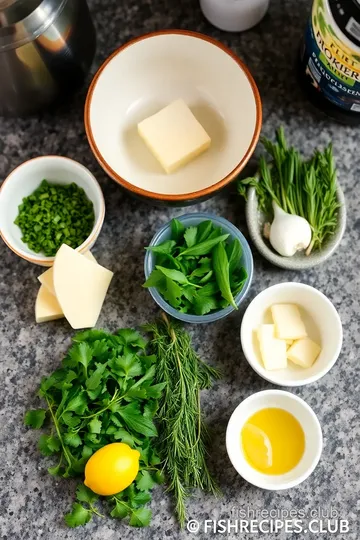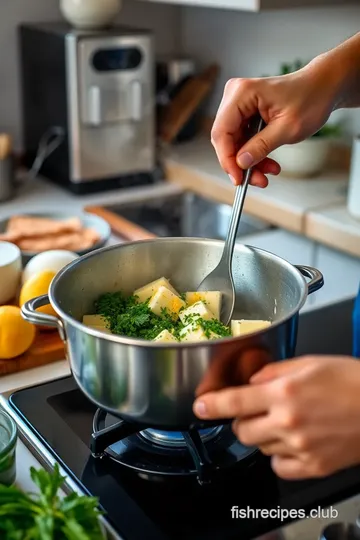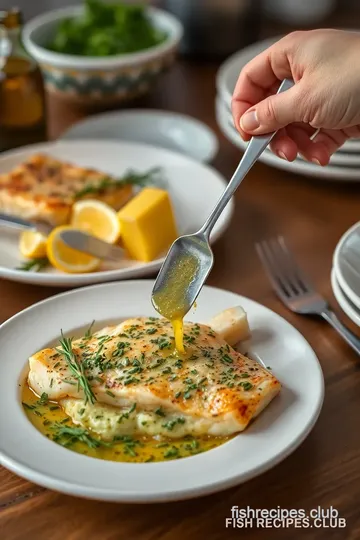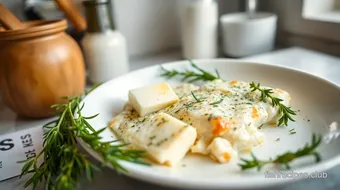Mixing Herb Butter for Fish Delight
Craving the best Mixing Herb Butter for Fish Delight? Try my simple herb butter recipe that's perfect for grilling or baking your favorite fish!

- A Flavorful Splash: Mixing Herb Butter for Fish Delight
- Let’s Chat About This Recipe!
- Why You'll Love This Herb Butter
- Ready to Get Started?
- Essential Ingredients Guide
- Cooking Like a Pro: Mixing Herb Butter for Fish Delight
- Pro Tips & Secrets to Mixing Herb Butter for Fish Delight
- Perfect Presentation: Making Your Dish Pop
- Storage & Make-Ahead Strategies
- Creative Variations: Mixing It Up
- Complete Nutrition Guide
- Wrap it Up
- Frequently Asked Questions
- Recipe Card
A Flavorful Splash: Mixing Herb Butter for Fish Delight
Have you ever taken a bite of perfectly cooked fish, and it just falls apart in your mouth? it’s like a little piece of heaven, right? okay, now imagine that same fish drizzled with herb butter that’s bursting with fresh flavors.
Honestly, it takes that experience from “yum!” to “oh my gosh, i need seconds!” that’s the magic of mixing herb butter for fish delight —a simple yet transformative recipe that’ll have your taste buds doing a happy dance.
Now, let’s get real. fish can be a tad intimidating to cook, especially if you're worried about it being dry or bland.
But when you whip up this easy compound butter for fish , you’re basically putting a flavor superhero on your plate.
Mixed with fresh herbs and just the right seasonings, this seafood topping adds a kick that makes every bite sing.
Let’s Chat About This Recipe!
A Touch of History
This recipe hails from the heart of french cuisine , where they've mastered the art of making everything taste amazing with just a little butter and herbs.
Over the years, it’s been adapted and loved by home cooks globally. today, you’ll find it featured in restaurants and kitchens alike, lighting up fish dishes from grilled salmon to baked tilapia.
It's become a staple not only because it's so delicious but also because it’s super easy to whip up .
Today’s Vibe
When i say this is an easy seafood recipe, i mean it! you’re looking at about 10 minutes of prep time and another half-hour chilling in the fridge.
That’s a total of 40 minutes to flavor town. the best part? this herb butter can transform even the simplest fish into a restaurant-worthy dish without breaking the bank.
With this recipe, you’re getting about 1 cup , or roughly 8 servings , of buttery goodness—perfect for those family dinners or those spontaneous gatherings where you want to impress your friends.
Why You'll Love This Herb Butter
Health Benefits Galore
Let’s talk about the nutrition highlights . while butter does have its calories, the flavor it brings—especially when paired with vibrant herbs —reduces the need for heavy sauces or additional oils.
You've got fresh parsley, dill, and chives all working together to create not just flavor, but an easy and delightful way to boost vitamins in your meal.
Perfect for Any Occasion
Now, ask yourself—when is a fish dish with herb butter not appropriate? whether it’s a cozy family weeknight dinner or a fancy date night, this dish shines bright.
Seriously, it’s like an all-access pass for deliciousness! plus, it’s a fantastic fish accompaniment that can elevate a tuesday taco night or dazzle your guests at a sunday brunch.
Unique Selling Points
I can’t stress enough how this recipe stands out from other butter recipes for seafood . the fresh herb butter is customizable! don’t have chives? no biggie, just toss in whatever herbs you have lying around.
Love spice? add a pinch of cayenne! it’s all about cooking with herbs and making it your own.
Ready to Get Started?
So, are you excited yet? because i know i am! you’re about to unlock the secrets of making herb butter just like a pro.
Gather your ingredients, roll up your sleeves, and let’s create something magical together. stay tuned, because coming up next, we’ll dive into exactly what you need to get this party started.
Let’s make your fish dishes the star of the night!

Essential Ingredients Guide
Alright, friends! let’s talk about the essential ingredients that’ll elevate your kitchen game from “meh” to “wow!” whether you’re a beginner or a seasoned chef, knowing these basics can be a game changer.
So, let’s jump right in!
Premium Core Components
First things first, it’s all about quality ingredients . you wouldn’t head to a steak restaurant for a rubbery piece of meat, right? same goes for your fish; you want to make sure you’re using premium ingredients .
For instance, when picking out fresh herbs, look for vibrant colors and avoid any wilting—dull leaves scream “i’ve been sitting on the shelf for too long!” if you're diving into mixing herb butter for fish delight , these ingredients are essential.
Here’s a quick reference for measuring both in us & metric :
- 1 cup unsalted butter = about 226 grams
- 1 tablespoon of fresh herbs = roughly 4 grams
Storing your ingredients properly extends their shelf life . herbs can go into a damp paper towel in a sealed bag in the fridge, while your butter should be wrapped tight to keep it fresh.
Trust me; no one likes a rancid butter surprise!
Signature Seasoning Blend
Now, let’s spice things up! a solid signature seasoning blend can make your taste buds do a happy dance. think about the classic combinations like parsley, dill, and chives for that sea-inspired vibe.
Don’t forget your flavor enhancers! toss in some garlic powder , a bit of sea salt , and you’ve got yourself a zesty herb butter that’s going to rock that fish.
And if you’re feeling adventurous, why not play around with regional variations ? a sprinkle of cajun spices or a pinch of italian herbs can transform your dish entirely.
Smart Substitutions
Sometimes, life happens. Maybe you’re missing an ingredient, or your diet requires a little tweak. No worries! Here’s where smart substitutions come to the rescue.
If you run out of fresh parsley, dried works in a pinch! you might want to scale it down since dried herbs are a bit more potent.
And hey, if you’re dairy-free, swap out that butter for some plant-based options —just ensure they’re still spreadable.
For those last-minute scrambles, having emergency replacements like lemon juice for fresh citrus can save your dish.
Kitchen Equipment Essentials
Now that you have your ingredients, let’s not overlook the tools! You don’t need a fancy kitchen to whip up your compound butter for fish . Here are some must-have tools:
- Mixing bowl : Get one large enough to hold your butter and herbs.
- Rubber spatula : Perfect for blending everything together.
- Plastic wrap or parchment paper : Essential for shaping your butter.
And don’t forget to have your refrigerator ready. it’s where your herb-infused butter can chill out and firm up. a little cooling time goes a long way in solidifying those amazing butter flavors for fish .
Wrapping It Up
In this kitchen adventure, remember to experiment. try new herb combinations , play with ratios, and embrace those happy cooking accidents.
You’ll not only learn about cooking with herbs but also find your own rhythm in the kitchen.
Next up, we’re diving into the easier part— instructions for mixing herb butter for fish delight ! you won’t believe how simple it is to elevate your dinner with this creamy, flavorful topping.
Let’s roll up those sleeves and get mixing!

Cooking Like a Pro: Mixing Herb Butter for Fish Delight
Alright, friends! today, i’m spilling the beans on a professional cooking technique that can elevate your seafood game like nothing else! we’re diving into mixing herb butter for fish delight .
If you’ve ever wanted to make your fish dishes sing with flavor, this bright, buttery wonder is a game changer.
So, roll up your sleeves and let’s get to cooking.
Essential Preparation Steps
First things first, let’s cover some key basics of cooking like a pro. If you want to whip up that herb butter like you’ve been trained in a Michelin-star kitchen, here’s how to get set up:
-
Mise en place is your best friend! Basically, it means having all your ingredients prepped and ready to go. Chop those fresh herbs—think parsley, dill, and chives—so they’re just waiting for you to say, “Let’s mix!”
-
Time management is crucial. While our herb butter is easy, setting a timer for 30 minutes when chilling helps you stay organized. Grab that timer app on your phone!
-
Getting organized at the start will save you from running around like a chicken with its head cut off. Gather your mixing bowl, spatula, and plastic wrap ahead of time.
-
And hey, let’s not forget safety considerations ! Always wash your hands after handling raw ingredients and be careful with that knife while chopping those herbs.
Step-by-Step Process
Here’s where we roll up our sleeves and get busy. Follow these numbered instructions to whip up that dreamy compound butter for fish .
-
Prepare Ingredients : Measure 1 cup of softened unsalted butter and chop those herbs. You want freshness—like you just came back from the farmers' market!
-
Mix butter : in that mixing bowl, throw in your butter and add 2 tablespoons of parsley , 1 tablespoon of dill , 1 tablespoon of chives , along with 1 tablespoon of lemon juice and a sprinkle of garlic powder, sea salt, and black pepper.
-
Combine : grab your spatula (or wooden spoon if you’re feeling rustic) and mix it all together until you’ve got a uniform color.
There’s no need for perfection here; it’s all about the flavor!
-
Shape Butter : Transfer the blend onto either plastic wrap or parchment paper. Roll it into a log shape. Keep it tight; think of it like wrapping a gift. Blissful butter surprises!
-
Chill : Slide it into the fridge for at least 30 minutes to firm up. You want it ready to slice and serve!
-
Serve : Slice off rounds and place them on top of your cooked fish. Wait for that ahhhh moment as it melts into the seafood.
Expert Techniques
Pro tips coming your way! Mixing herb butter is simple, but here are some critical steps to nail that recipe every time.
-
Temperature control : make sure your butter is room temperature. if it's too cold, it won’t blend well. but if it’s too soft, it’ll be a mess.
Aim for 65° f —it’s the sweet spot!
-
Timing precision : when you’re cooking fish, timing is everything. unlike those “10-minute abs” workouts, we don’t want to rush here.
Depending on the thickness, a 6-8 minute grilling on each side for fish is ideal. just keep an eye on it!
-
Visual Cues : Look for that beautiful flaky texture when your fish is done. If it flakes easily with a fork, you’re winning.
Success Strategies
Avoid common pitfalls while on your culinary journey. Here’s what to watch for.
-
Common mistakes : Don’t overmix the butter. You want it fluffy, not whipped into oblivion.
-
Quality assurance tips : Taste as you go! A little sprinkle of sea salt here and there makes a world of difference.
-
Perfect results guide : For a next-level experience, consider adding spices like smoked paprika for a smoky vibe or lime zest for a zesty twist.
-
Make-ahead options : This butter can chill out in the fridge for up to two weeks or freeze for an easy seafood topping later. Just slice off what you need!
And there you have it! mixing herb butter for fish is more than a recipe; it’s a culinary hug for your taste buds.
Whether you’re grilling, baking, or pan-searing, that herb butter will make your fish shine.
Up next, we’ll explore some Additional Information on pairing herbs with different types of seafood, fun variations, and more tips to keep your cooking game strong. Let’s keep the flavor train rolling!

Pro Tips & Secrets to Mixing Herb Butter for Fish Delight
When it comes to mixing herb butter for fish , i’ve learned a few tricks to take this simple recipe from good to unforgettable.
First off, let’s chat about softened butter . make sure it's really soft – not melted! this makes mixing easy-peasy. you wanna create a smooth mix where the herbs and spices blend beautifully into that rich, creamy goodness.
Time-saving hacks? oh, i got your back! if you’re in a rush, skip the chopping by using kitchen scissors to snip the herbs directly into the bowl.
I once had my friends over and was hustling to make this butter, and let me tell you, those scissors saved the day!
Flavor enhancement? i swear by a splash of lemon juice to brighten things up, but if you’re feeling adventurous, sub in some zest too.
Seriously, it’s a game changer! and don’t forget about garlic powder – it’s like that secret seasoning that jazzes things up without overpowering your fish.
When you’re ready to serve that herb butter, how you plate it matters! never underestimate the power of a good garnish.
A sprinkle of fresh herbs on top not only looks chic but also shows you really care about your presentation.
Trust me, your friends will think you’re a pro chef!
Perfect Presentation: Making Your Dish Pop
Okay, let’s talk presentation. a dish that looks good often tastes better, right? so how do we plate this delight? first, scoop a good tablespoon of your herb butter right onto the fish.
As it melts away, it creates this beautiful, glossy finish.
Next, think about colors. a vibrant green herb butter on a sizzling piece of white fish creates a stunning visual! you could even throw on a few lemon wedges or slices for that extra pop of color.
It’s not just for looks; the bright colors tell people, “hey, eat me!"
And don’t shy away from garnishing. fresh herbs work wonders as a topping. chives or parsley make a delightful finish, and a sprinkle of sea salt and pepper seasoning takes your dish to another level.
You know, it’s all about making it look as yummy as it tastes!
Storage & Make-Ahead Strategies
Let's be real: life gets busy, and that's why this herb butter is a total lifesaver. you can whip it up ahead of time.
Just store it tightly wrapped in plastic wrap in the fridge. it lasts about 2 weeks – because who doesn’t love having convenience at their fingertips? if you wanna keep it longer, toss it in the freezer for around 6 months ! just slice off what you need and let it thaw out.
Easy peasy!
When it’s time to reheat, know that you don’t need to blast it in the microwave. just add a bit of warmth to the fish as it cooks, and the butter will melt perfectly.
Nobody likes a rubbery mess, am i right?
Creative Variations: Mixing It Up
Now for the fun part— creative variations ! This is where you can get wild with that flavored butter for fish . Don’t feel boxed in by the recipe; get creative!
Spicy herb butter is a hot favorite of mine. toss in some red pepper flakes for a kick! or, wanna bring a smokey flavor to your grilled fish? mix in a bit of smoked paprika.
That smoky, zesty twist? chef's kiss!
If you’re feeling seasonal, throw in some fresh basil and lemon zest during summer for a refreshing twist or swap in sage for that cozy fall vibe.
There’s just something about changing up the herbs that can turn a familiar dish into something exciting.
Complete Nutrition Guide
Let’s not ignore the health benefits! this herb butter recipe packs a punch in flavor while still being manageable in calories.
Each serving is roughly 100 calories but brings so much joy without guilt. pair it with lighter fare, like grilled veggies or a fresh salad, to balance things out.
You can feel good about this buttery goodness working hard for you. it adds essential fats to your meal while keeping the focus on those omega-3s in the fish.
Plus, the fresh herbs are packed with antioxidants. just like that, you’ve got a delicious and nutritious option for dinner!
Wrap it Up
In the end, mixing herb butter for fish delight is simple, fun, and oh-so-rewarding. from jazzing up your grilled fish to creating stunning plates that impress even the pickiest eater, this butter is a kitchen hero! look into into the world of compound butter for fish , and watch your meals transform into something extraordinary.
So go ahead, experiment, and enjoy! you got this!
Frequently Asked Questions
How do I make Mixing Herb Butter for Fish Delight?
To make Mixing Herb Butter for Fish Delight, simply soften unsalted butter and mix it with finely chopped fresh herbs, lemon juice, garlic powder, salt, and pepper in a bowl. Once combined, shape it into a log using plastic wrap, chill for at least 30 minutes, and then slice as needed for serving on fish.
Can I add more herbs to the Mixing Herb Butter for Fish Delight recipe?
Absolutely! Feel free to experiment with various herbs such as tarragon, basil, or cilantro for different flavor profiles. Just keep in mind to balance the flavors and start with small amounts to avoid overwhelming the butter.
How should I store leftover herb butter?
Leftover herb butter can be stored tightly wrapped in the refrigerator for up to 2 weeks. For longer storage, you can freeze it in individual portions for up to 6 months, allowing you to enjoy this delicious topping for fish whenever you want!
What type of fish best pairs with the herb butter?
This herb butter pairs perfectly with mild fish like cod, tilapia, or salmon. The buttery herb flavor complements seafood delicately, enhancing their taste without overpowering the fish.
What are some variations I can try with this herb butter?
You can try adding spices for extra flavor, such as cayenne pepper for a spicy kick or smoked paprika for a smoky essence. Additionally, using lime or orange juice in place of lemon juice can offer a refreshing twist!
Is this herb butter recipe healthy?
While this herb butter adds indeed richness and flavor to your dishes, it is high in calories and fat, primarily from the butter. However, using it in moderation can elevate your meals, and the use of fresh herbs adds nutritional benefits like vitamins and antioxidants.
Mixing Herb Butter for Fish Delight Card

⚖️ Ingredients:
- 1 cup unsalted butter, softened (226 grams)
- 2 tablespoons fresh parsley, finely chopped (8 grams)
- 1 tablespoon fresh dill, finely chopped (4 grams)
- 1 tablespoon fresh chives, finely chopped (4 grams)
- 1 tablespoon lemon juice (15ml)
- 1 teaspoon garlic powder (5 grams)
- 1/2 teaspoon sea salt (2.5 grams)
- 1/4 teaspoon freshly ground black pepper (1 gram)
🥄 Instructions:
- Step 1: Prepare Ingredients: Gather and measure all ingredients. Finely chop the fresh herbs.
- Step 2: Mix Butter: In a mixing bowl, place softened butter. Add chopped herbs, lemon juice, garlic powder, salt, and pepper.
- Step 3: Combine: Use a rubber spatula or wooden spoon to mix until all ingredients are well combined and it forms a uniform color.
- Step 4: Shape Butter: Transfer the butter mixture onto a piece of plastic wrap or parchment paper. Roll it into a log shape
- Step 5: Chill: Place the wrapped butter in the refrigerator for at least 30 minutes until firm.
- Step 6: Serve: Slice rounds of herb butter as needed to serve atop cooked fish.
Previous Recipe: Easy and Delicious Baked Lemon Herb Fish for a Quick Dinner
Next Recipe: Easy Southern Crispy Catfish with Flavorful Hillbilly Seasoning: A Family Favorite!
